

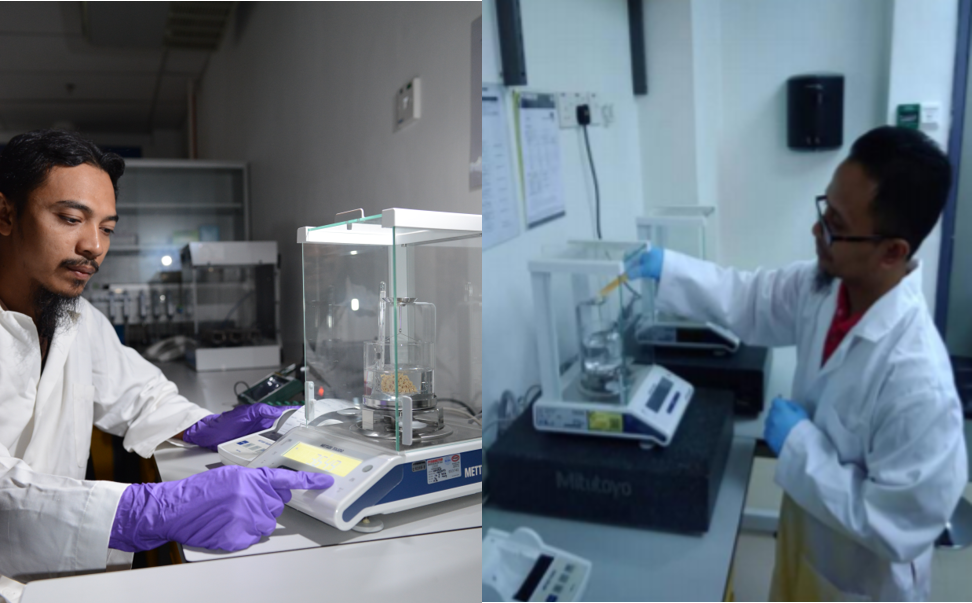 Assuring the safety of materials used in the development of medical devices includes a critical assessment on
physico-chemical of the manufactured products. Our laboratory offers comprehensive physico-chemical characterization services according to standard documents such as ISO and ASTM, including:
Assuring the safety of materials used in the development of medical devices includes a critical assessment on
physico-chemical of the manufactured products. Our laboratory offers comprehensive physico-chemical characterization services according to standard documents such as ISO and ASTM, including:
Density covering the domain of True Density, Apparent Density and Apparent Porosity by using gravimetric
technique assisted by density kit (ISO 18754).
 Surface Porosity in term of specific surface area analysis by Brunauer-Emmett-Teller surface analyser.
Surface Porosity in term of specific surface area analysis by Brunauer-Emmett-Teller surface analyser.
BET (Brunauer, Emmett and Teller) the specific surface area of a sample is measured- including the pore size distribution.
The specific surface determined by BET relates to the total surface area (reactive surface) as all porous structures adsorb the small gas molecules. This information is used to predict the dissolution rate, as this rate is proportional to the specific surface area. It is useful to evaluate the product performance and manufacturing consistency.
The standard used is ISO 18757: Determination of specific area of ceramic powders by gas adsorption using the BET method.
Surface Morphology by Scanning Electron Microscopy that comprise particle size determination which involves particle size criteria by equivalent circle diameter and particle shape by aspect ratio determination (ASTM F1877-98).
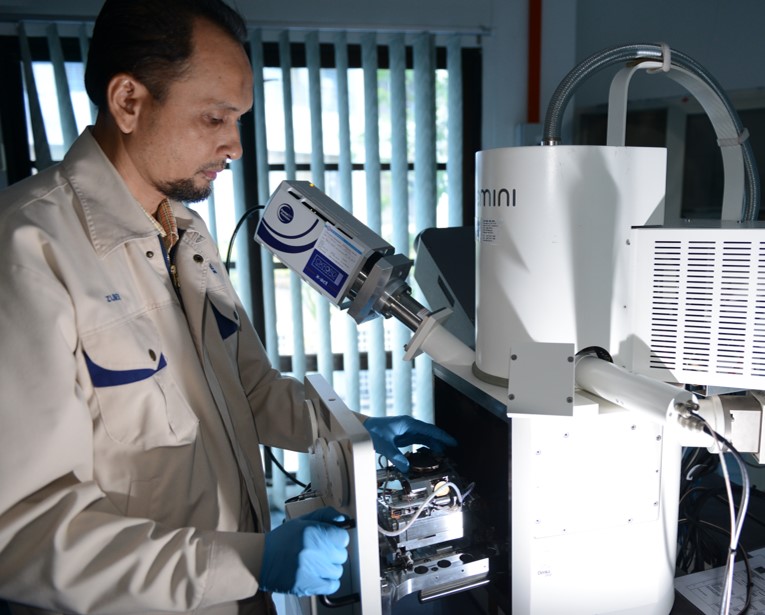
Surface Topography covering 3D roughness profiling and particle size determination through (ASTM 2859-11).
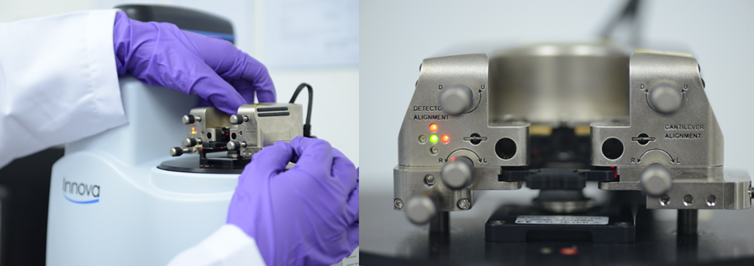
Crystallization in term of material crystallinity by X-ray diffractometry technique (ASTM ). This includes crystal peak identification with verification by standard crystal database reference from International Centre for Diffraction Data (ICDD). Crystal size determination is also provided.

 Carbon / Sulfur Analysis in Iron, Steel, Nickel-Base, and Cobalt-Base Alloys and in Refractory and Reactive Metals in Accordance with ASTM Standard
Carbon / Sulfur Analysis in Iron, Steel, Nickel-Base, and Cobalt-Base Alloys and in Refractory and Reactive Metals in Accordance with ASTM Standard
Carbon Sulfur Analyzer lab offers a Carbon and Sulfur content analysis techniques for a wide range of primary steels, ores, finished metals, and other inorganic materials. We have the expertise to perform these elemental analysis at levels ranging from percentage to parts per million in metals and various other materials.
LECO has been one of the leading manufacturers of elemental analyzers. Our LECO's CS744 Carbon Sulfur Analyzer Series will redefine the way you determine carbon and sulfur with improved Cornerstone brand software platform, powered by a touch-screen interface to increase usability and lower the cost-per-analysis. Additional features—such as a high-frequency combustion furnace, improved IR cell design, rugged design, and available automation
E1019 – 11 “Standard Test Methods for Determination of Carbon, Sulfur, Nitrogen and Oxygen in Steel, Iron, Nickel and Cobalt Alloys by Various Combustion and Fusion Techniques”
E1941 – 10 “Determination of Carbon in Refractory and Reactive Metals and Their Alloys by Combustion Analysis”
ALPHA L Rotational viscometer, based on the measurement of the torque of a rotating spindle in a sample at a specified velocity. It is equipped with 4 standard spindles.
* Measuring range 20-2000.00 cP
* Speed 0.3-100 rpm
ISO 2555:2018 Plastics — Resins in the liquid state or as emulsions or dispersions — Determination of apparent viscosity using a single cylinder type rotational viscometer method.
The method is applicable for Newtonian and Non-Newtonian liquids, and viscosity measuremens in the range of 200 cP to 60 000K cP
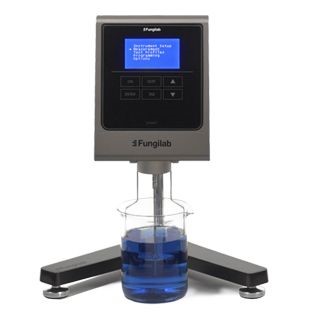 Rotational Viscometer
Rotational Viscometer
Model: Alpha L (low viscosity)
Brand : Fungilab
 Density is weight per unit volume. It is a key property in the identification, characterization and quality control of a wide range of materials. Density measurements in terms of weight per gallon are commonly used to check paint quality. If the density is not within specification there is a good chance that there was a mischarge or other serious problems.
Density is weight per unit volume. It is a key property in the identification, characterization and quality control of a wide range of materials. Density measurements in terms of weight per gallon are commonly used to check paint quality. If the density is not within specification there is a good chance that there was a mischarge or other serious problems.
This test method is suitable for the determination of density of paint and related products and components when in liquid form. It is particularly applicable when the fluid has too high a viscosity or when a component is too volatile for a density balance determination.
The accurately known absolute density of distilled water at various temperatures is used to calibrate the volume of a trainer. The weight of the paint liquid contents of the same container at the standard temperature (25C) or at an agreed-upon temperature is then determined and density of the contents calculated in terms of grams per millilitre, or pounds per gallon at the specific temperature.
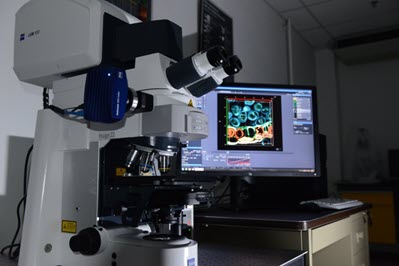 As one of the most important physical phenomena, fluorescence microscopy has become one of the most used microscopic tool in modern biology and medicine field due to its’ sensitivity and specificity. Fluorescence microscope permits the present and localization of very small amount of molecules in biological sample. Especially in cell. Related scientific and R&D activities on co-localization and interaction can also be performed. Studies on cell activities such as ion transport as well as intra- and intercellular processes such as endocytosis and exocytosis can be obtained.
As one of the most important physical phenomena, fluorescence microscopy has become one of the most used microscopic tool in modern biology and medicine field due to its’ sensitivity and specificity. Fluorescence microscope permits the present and localization of very small amount of molecules in biological sample. Especially in cell. Related scientific and R&D activities on co-localization and interaction can also be performed. Studies on cell activities such as ion transport as well as intra- and intercellular processes such as endocytosis and exocytosis can be obtained.
Confocal microscope is special type of fluorescence microscope with capability on focusing using pin-holes technology for redefining live science imaging into sub-micron resolution dimension. By the ability to vertically obtain images at different heights, it opens the opportunity for images reconstruction at 2D and allows detection of fluorescent images in 3D with good spatial resolution.
The standard method used for the test is ISO 25178: Geometrical Product Specifications (GPS) Surface Texture-Areal